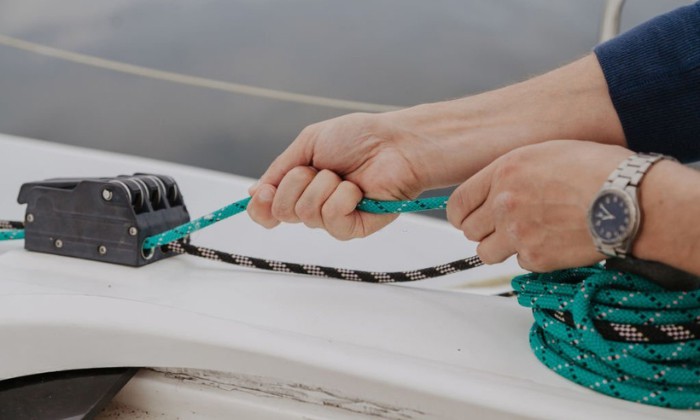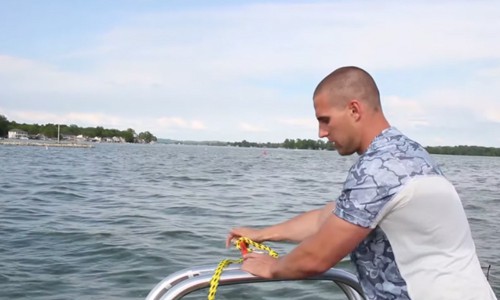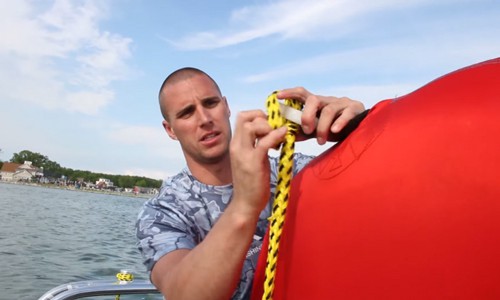From wakeboarding to waterskiing, engaging in watersports is a top reason for investing in a boat.
But do you know how to attach a tow rope to a pontoon boat? In this short guide, we’re showing the detailed steps, so you can do it without additional costs from availing of a professional service.
Learning how to attach a tow rope is crucial to avoiding accidents and injuries. From checking the rope’s condition, hooking it through the attachment point on the boat, to tying secure knots, here’s how to properly do it.
Table of Contents
Pontoon Boat Tow Rope Attachment: A Step-by-Step Tutorial
1. Know the Rope to Use
Before learning to attach a tow rope to a boat, know the rope most suitable for your boat and your needs. The Water Sports Industry Association (WSIA) has recommendations regarding rope tensile strength and the riders’ weight.
For example, if you need to tow a total of 170 lbs, you need 1,500 lbs of rope strength. For 510 pounds of weight, the corresponding capacity should be 3,350 pounds.
However, the best option is to check with the rope manufacturer or an expert for the correct towing rope for your boat or tube’s weight and the weight of the riders.
Rope Length
There are different lengths of rope to use depending on your intended purpose.
- If you are towing devices, the rope length for tubing should range from 50 to 60 feet. Take note so that when you are tubing behind a pontoon boat, your gear can execute the job.
Any shorter or longer can make the towable tough to maneuver. The last thing you want is to be unable to tow or worse, snap the rope from overexertion.
- If you are going to do water sports like wakeboarding, the rope length ranges from 65 to 75 feet. But if you are going to try some water skiing, the ideal rope length is 75 feet.
The difference between the two sports is that wakeboarding requires a wide board and entails a lower speed (19-22 mph), while water skiing involves twin skis and faster speeds (26-34 mph).
The extra length on water ski ropes helps with shock absorption, while shorter wakeboarding ropes enable better trick execution.
Material of Rope
- Polypropylene or Spectra
These are both high-quality, non-stretch synthetic materials. They are ideal for water sports like wakeboarding and waterskiing, since the fiber is strong and mold-resistant.
- Bungee cord
This rope is stretchable, making it suitable if you want to hook a tube. It is an ideal tow rope for a pontoon boat. Since it stretches and contracts, the elasticity allows more flexible movement.
2. Before Attaching the Tow Rope
To prepare, check the rope for any signs of damage. This includes fraying, rusting or stains, knots along the length, and other indicators of wear.
- Typically, a pontoon boat tow harness has a hook or a pylon so that it is easier to attach.
- Some boat models have a ski tow bar or a pontoon tow bar for tubing. Some types like the Turboswing hug the entire device so that when pulling the rope, the weight is evenly distributed.
- Now, how do you pull a tube without a tow bar? You can buy a ‘Y Harness’ and connect it to the tow eyes on the transom.
3. Step-by-Step Guide
Attaching a ski rope to towing eyelets can be a DIY task. However, it takes precision to ensure that your rope is properly and securely fastened. Otherwise, you can risk accidents during towing, such as the rope coming loose or suddenly snapping from excess weight.
- Pass one end of the rope through the boat’s attachment point.
For most boats like the pontoon, you can find the attachment on the stern or the V-shaped hull. It is a round structure where you can either hook the rope or tie it around.
Others, as mentioned, have tow bars for even weight distribution or ski pylons.
- Once you pass the rope through the attachment point, tie a knot.
You must ensure the knot is secure. You can check this by tugging at the rope’s other end. If it feels loose, redo the knot or add another.
- Make a loop on the other end of the rope to connect it to the water sports gear.
Similar to the first end, connect the rope’s other end to the attachment point of the other device (e.g. inflatable or person on a wakeboard). You can tie a tube to a boat first to make the towing easier.
Again, make sure each of the knots is secure to avoid any accidents while towing.
You can watch the tutorial video here or here.
Conclusion
Rope attachments are generally easy to do. All you need is to know the weight of yourself and any fellow riders, so you know what type of rope to use. Secure every loop or knot you do so that they won’t come off while towing.
This is crucial, especially in rough water sports like wakeboarding. If you are still uncertain about how to attach a tow rope to a pontoon boat, you can always consult a professional to check your work.

Ten years of enjoying countless trips on boats never made me love them any less! So I am here to put all those experiences into good use for other boaters who want to have a safe and fun trip with their friends and families.









